It was tempting to write a headline that said 12 days of pepperpot, but I cannot tell a lie. The pepperpot that has been sitting sturdily on my stovetop has been only going for 11 days.
It is the remnants of the excursion into learning how to make the dish from Lynette.
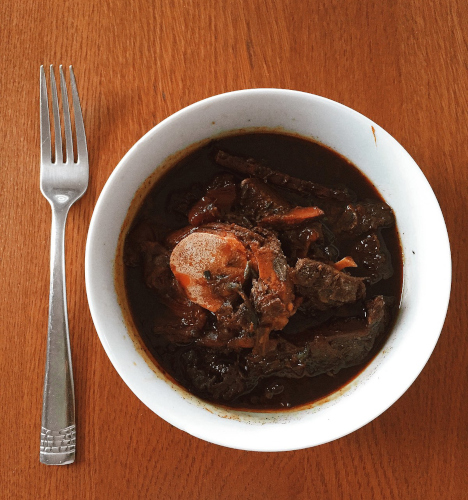
As I mentioned last week, it was a delightful day of sharing stories about home cooking and memories of pots past from everyone present. On that occasion, it was a fairly big pot with a mixture of meats: glooby glooby from the cow heel and oxtails; rich and dark from the thick black cassareep (straight from Guyana); slightly sweet from the spoonful of sugar and the cinnamon sticks (straight from Grenada); savoury from herbs, cloves and the whole Scotch bonnet peppers (no wiri wiris to be found).
When everything had been cleared away, devoured really, and portions packed for takeaway, there was a small amount left.
I transferred it to a tiny pot, and decided I would test its famed longevity by leaving it on the stove and heating it gently every day (as instructed), and sampling a couple pieces to see how it was faring. It has been a source of delight for my curiosity. Every tasting was an adventure.
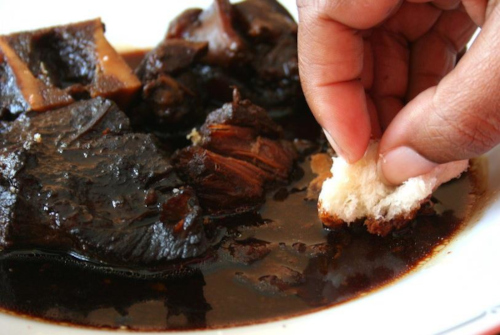
On the 10th day, I helped myself to a small serving on a bed of rice. It was an arresting moment. The taste was so exquisite, the flavours so immeasurably developed, that I could taste each ingredient singly, yet so infused with the others that it was a little disorienting.
They were together, yet apart, distinguishing each other by what seemed to me to be a celebration of each other’s individual character—a life lesson perhaps?
The cook in me understood this marrying of flavours; the scientist in me marvelled at what the ancient ones had discovered about the preserving quality of the bitter cassava juice. How did they know to extract it with such care that the inherent toxicity was transformed into something that enabled food to last so long without modern methods?
I know the old cultures found ways to preserve food: drying, salting and fermenting being the most common ones. But cassareep comes from something toxic. How did they get past that?
My little pot’s contents, now so reduced that I doubt they will last for many more days, will probably deny me the chance to take it to the limit; to see how long it could go before spoiling, but I am determined to keep tasting to the very end. I now understand why this dish, the famed Guyanese pepperpot, remains such a stalwart of traditional foods.

I know there are those who find it a bit much, not pleasing to their palates, but I am a convert. The first time I had it was at the Pegasus Hotel in Guyana, maybe 30 years ago, when they had served it at breakfast with bread.
It had seemed too rich and cloyingly sweet for my taste so early in the morning, but Lynette’s version was magnificent from the start, and I believe its pedigree is confirmed by the way the taste has just exploded with age.
I was telling my Muslim mother about this day we had spent over the pepperpot, and she recalled a childhood story that was as perplexing as it was intriguing.
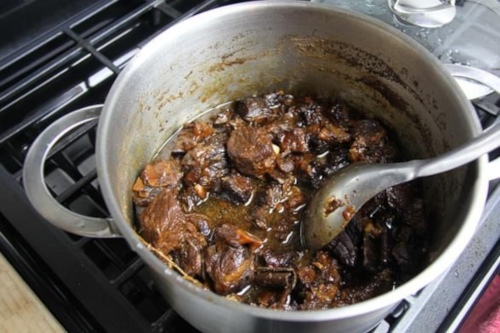
She and her neighbour’s daughter, Paula, were close friends, and they would be back and forth in each other’s homes. She told me that there was a big glass jar that they kept their pepperpot in, stored in a cupboard.
I told her that couldn’t have been pepperpot, because it was meant to be heated daily to help the preservation process, and suggested it might have been the Portuguese garlic pork being marinaded in its vinegary brine.
She insisted it was black and glossy, and that it was served only on special occasions, but Paula would steal bits of meat regularly. She herself never partook because of the pork, but regardless of the possibilities I proffered that it could have been something else, she was adamant that it was pepperpot.

I asked Lynette about whether this was plausible and she couldn’t understand it, saying that it would have probably made them ill at best, if that was the way it was being stored.
I went online to see if I could find any instance of this method of storage but there was nothing, except confirmations of the daily gentle heating. What I also discovered was that many people didn’t understand the role of the cassareep in the dish. It isn’t simply a flavouring agent; it is the preservative that creates its long life.
One person said she had used molasses as a substitute and it was just fine. I assume her meal was consumed all at once. Many asked if they could just caramelise sugar to give it the famous Caribbean stewed colour.

Photo: Guyana Chronicle
The questions and suggestions indicated that many people don’t know either the genesis or the concept of the pepperpot.
Cooking is a combination of science and art, I believe. It’s why I’m so fascinated by it. My next project is to look at our culinary history; the stories behind how our foods arrived in this bounteous place, and how we’ve made them our own. I look forward to an adventurous 2024, and I wish you the same.
 Wired868 Wired868 for smart sport news and opinion
Wired868 Wired868 for smart sport news and opinion

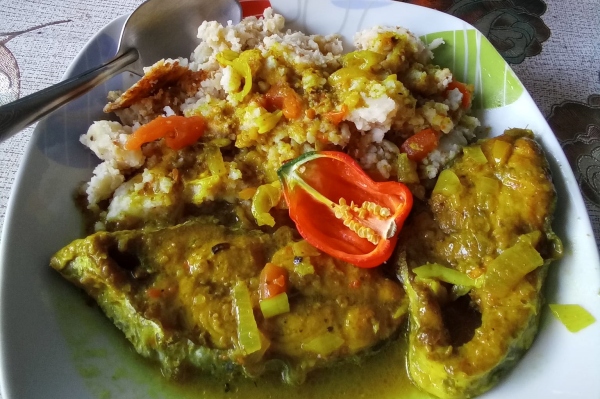

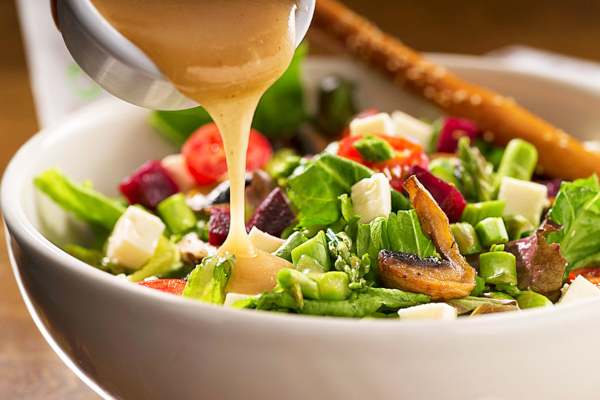




I’ve heard of this for over 50 years having visited Guyana in 1972, but never had the good fortune of tasting it. How can I get a bottle of a famed casareep and the Lynette recipe? I would love to try it. Thanks in advance for opening my appetite by your story.